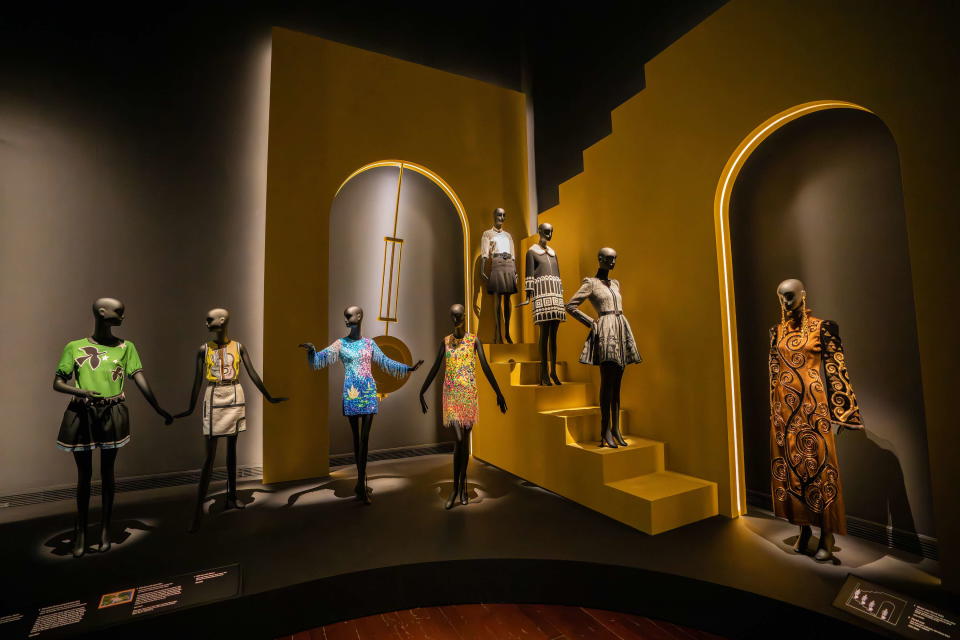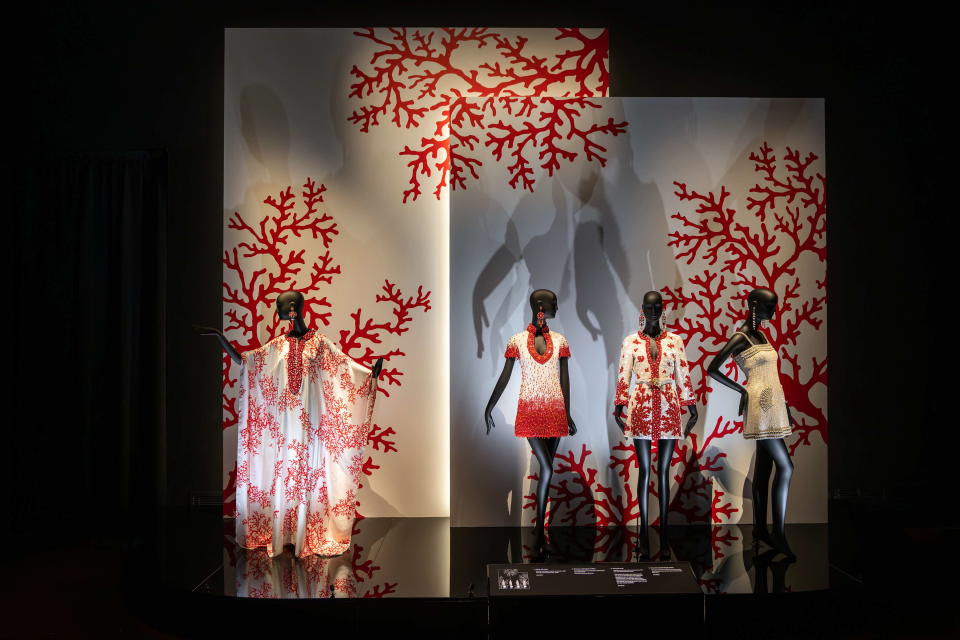Singapore Fêtes Andrew Gn and Retrospective at Asian Civilizations Museum

SINGAPORE — “Welcome home, Andrew.”
Signing off a profile in the exhibition catalogue of “Andrew Gn: Fashioning Singapore and the World,” the words of author Tan Siok Sun embodied the feeling in the Asian metropolis as the Paris-based designer, who’s deemed “Singapore’s best fashion export,” made his homecoming.
More from WWD
“This exhibition celebrates Andrew [Gn’s] career as an international and Singaporean fashion designer. It explores how Andrew and his body of work further the notion of a global Singapore, a small Singapore but [a nation that] punches above its weight,” said Asian Civilizations Museum and Peranakan Museum director Kennie Ting. “And it celebrates Andrew’s unique ability to craft objects of great beauty from the blending of materials, motifs, silhouettes and sensibilities drawn from East and West.”
As the island nation shakes off the last of the COVID-19 pandemic and visitors — mainly Western and South Asian for now — make their return to the city, it felt like the moment to show how “cultures and civilizations have always been in contact with connecting and mutually interacting with each other,” and “that we don’t exist in silos and never have,” Ting told WWD.
Beyond a celebration of Gn’s career, this first-ever retrospective and his “gift to the [Singaporean] nation” donation of 160 pieces were also meant as a strong signal of Singapore’s desire to spearhead discussions on “how Southeast Asia changed the world, how [Singapore] is a conduit to the world rather than this idea that [any particular nation or origin] is strong,” particularly in “this age of national posturing, at the geopolitical level,” Ting said.
Adding contemporary fashion design to the 100,000-strong archive of artifacts — only around 2 percent is exhibited at any time — is also a strong signal that “civilizations don’t stop,” he continued.
The Gn archive is the first significant step in expanding the city-state’s national collection, as part of an ambitious “Our SG Heritage Plan 2.0” launched earlier this month, said ACM and Peranakan Museum chairman Mark Lee.
In Lee’s eyes, the institution’s exploration of Asia’s history and position as a connecting global hub was “vital on the national and diplomatic level” as it signaled the country’s “spirit of openness to people and ideas from across Asia and the globe,” regardless of their race or creeds.
Prominent photographer Russel Wong found it “wonderful to see a whole body of work and not judge a person just by outfit.” But it was even more important that the exhibition celebrate Gn and not just a legacy.
“That body of work, if it doesn’t exist when you’re living, then you can’t show it. It’s good that you’re still around and kicking it,” Wong said. “We have a lot of years to spare, then people can still be inspired and [that] makes a lot of difference, especially here in Singapore, [which is] so academically driven and [where] the arts are not [seen as] something to take seriously.”
The opening section in Gn’s exhibition at the Asian Civilizations Museum, Singapore’s national museum of Asian antiquities and decorative arts, centered on his most recent work and the “impact of [his work] on public visual identity,” Ting said.
![The opening section of the <a href="https://wwd.com/fashion-news/designer-luxury/fashion-parties-move-to-zoom-coronavirus-1203626392/" rel="nofollow noopener" target="_blank" data-ylk="slk:Andrew Gn;elm:context_link;itc:0;sec:content-canvas" class="link ">Andrew Gn</a> exhibition showed designs worn by public faces and highlighted “impact of [his work] on public visual identity,” for ACM director Kennie Ting.](https://s.yimg.com/ny/api/res/1.2/4M75MoWjlE3uZBXF.PfWBA--/YXBwaWQ9aGlnaGxhbmRlcjt3PTk2MDtoPTcyMA--/https://media.zenfs.com/en/wwd_409/1d313a20d74c428b5d027510382ac23a)
“What we want to bring out again and again is how contemporary [Gn] is,” said ACM’s senior curator Jackie Yoong, by starting with a plinth on Asia-based celebrities including Fan Bing Bing, Hong Kong’s Carina Lau or Liu Yu Xin, who wore a richly embroidered gold jacket for his performance at the Chinese Communist Party’s 100th anniversary gala in 2021, followed by a subset on European royals, such as Denmark’s Crown Princess Mary, who wore a pink puff-sleeved number to King Charles III’s coronation reception for overseas guests at Buckingham Palace on May 5.
A third plinth cements Gn’s presence on Western stages and screens, ranging from a black minidress with pagoda shoulders worn by Lily Collins in the third season of “Emily in Paris” and a lace number seen on Emma Stone in “La La Land” to gowns worn by Beyoncé, Jennifer Lopez and Lady Gaga.
To Yoong, this wide range of profiles highlighted the way Gn’s designs were “used by celebrities to project glamour and also as a form of power dressing internationally,” with royals and first ladies seeking the designer’s classic elegance and famous faces attracted to his ability to “strike that difficult balance between maximalism, opulence and yet being subtle.”
Further into the museum, accessible through galleries that explore the cultures and the numerous faiths intersecting in the region, Gn’s “East-West style that align with the stories that [the ACM] tells” is explored.
Intended as a circular narrative, the two galleries can be entered in different doors at either end. Stepping in from the left highlights the impact of Western art in his work, with a sweeping overview that runs from Madame de Pompadour and the Baroque period to the Viennese Secession movement, Claude Monet’s paintings and even the Swinging ’60s.
Entering via the right door takes visitors into Gn’s heritage and interpretation of Asian cultural elements. Connecting East and West is a section on the natural world, with the marine and floral world, in particularly the coral and butterfly motifs that he favors.
“We particularly think that it’s important to start the Asia side with his ideas of Southeast Asia and where he comes from in Singapore,” said Yoong, highlighting a photograph of Gn’s grandmother Chen Mei Zhi in a traditional Peranakan outfit featuring a trio of “kerosang” brooch closures juxtaposed with a fall 2022 dress worn by Queen Rania of Jordan and its trio of bejeweled buttons.
Among the most important pieces in the 112 on display was a long balloon-sleeved gown from his “Hope and Glory” fall 2021 collection, printed in chinoiserie motifs embroidered with glass beads. For Yoong, it epitomizes the back-and-forth between Eastern and Western gazes, with Gn reprising landscapes and figures from an English screen from his personal art collection, itself inspired by Chinese Coromandel screens.
Further blending the two hemispheres of Gn’s creative identity was the soundtrack composed by Singaporean sonic artist Chong Li-Chuan, who used both Eastern and Western instruments.
In the fifth and final section of the exhibition, Gn’s Parisian world is explored, through an evocation of his studio through embroidery research, collection sketches and textile swatches, as well as a reproduction of the 1998 Colette window dedicated to his work, also visible from outside the museum.
Longtime friend Julia Shain-Hüsken, who met Gn in the mid-’90s and became his first right hand in 1996, described meeting him as a “magical, joyous, delightful rush” and recalled how the designer was “always proud of his heritage, even at a young age.”
That much was clear during a later visit of the ACM’s sister institution, the Peranakan Museum, where the designer supplemented the docent’s explanations with gusto, adding colorful evocations of his family’s home, the traditions that underpinned anything from furniture choices to traditional jewelry, and details on specialized crafts.

Many of these elements found themselves distilled into Gn’s work, alluded to in the form of buttons, informing a collar shape or the way his silhouettes are layered.
Farfetch executive Elizabeth von der Goltz, who has known Gn for two decades, praised his ability to “really understand the customer” and offer designs so original that “you’re not usually going to walk into a room filled with women wearing the same dress,” thanks to his talent for sophisticated designs.
For “Crazy Rich Asians” star Fiona Xie, Gn being “full of fun, jolly and full of love” is the wellspring of his creativity. “His work just reminds me of the good life,” she said.
“It’s really nice to see who wore these clothes and where, almost like milestones of history, and seeing the power of fashion and clothes, uniting all kinds of nationalities, all kinds of events,” she continued. “Like us being here, just celebrating humanity and celebrating life. That’s what fashion should be: fun and uniting people.”
According to Judith Chung, a prominent Singaporean retailer whose now-closed multilabel fashion boutique A Man and His Woman introduced the likes of Issey Miyake and Kenzo Takada to the city, Gn’s body of work skewed neither Eastern nor Western. Rather, she was left impressed by the versatility of the designs he has produced and “the extent of creativity that he has gone through in his works.”
And this is what the cultural institution hopes will permeate into a new audience and coming generation, with the addition of interactive elements such as NFC bracelets used to virtually collect Gn’s signature motifs and turn them into a digital outfit, or hands-on workshops to drape or create embellished paper collars.
In Gn’s sights are also the rising Asian creatives in the region. “I’ve always felt that that’s so important for a museum because, first, fashion really draws younger people to the museum. And second, it also creates a way of educating your next generation,” said the designer, who envisions his pieces as the start of a study collection that will draw students from the entire region.
“Our approach to working in the space of fashion is one where we cannot divorce ourselves from the industry and the community,” said Ting, highlighting a two-year effort that included the #SGFashionNow guerrilla pop-up exhibitions in collaboration with the Lasalle College of the Arts, and other initiatives with the Singapore Fashion Council to promote local contemporary designers.

“We’re always striving to find these original narratives that makes sense for us,” Ting said, noting that both public and private funding allowed for the development of narratives reflecting Singapore’s long heritage as a centuries-old port city and the vitality of the 50-year-old nation.
Private support is already flowing in, as evidenced by the ACM’s fundraising gala, celebrating the museum’s 25th anniversary and attended by Singapore’s minister of culture, community and youth Edwin Tong; ambassador for Singapore to France Foo Teow Lee and predecessor Zainal Mantaha, who initiated the retrospective project; British high commissioner to Singapore Kara Owens; Farfetch’s vice president for Greater China Judy Liu, and figures from Singapore high society, like former actress and investment director Sharon Au.
The evening, which included musical performances by jazz star Alemay Fernandez, the Gamelan Singamurti ensemble and DJ Koflow, surpassed the initial high mark of 800,000 Singapore dollars (or $592,500) set by the organizers and could hit the 1.3 million Singapore dollar mark, according to gala chair Paige Parker, who felt that fashion entering the museum was a milestone achievement.
“We are grateful because it’s been a long time coming for fashion to be relevant and [for] people to appreciate it for its own merit as a craft and an art form,” she said, joking that donors had “drunk the Kool-Aid” in that respect and lauding the panache Gn had brought to the proceedings. “Without him, a party wouldn’t have been as sexy. Fashion always makes everything sexier.”
Launch Gallery: Inside the Andrew Gn Retrospective
Best of WWD

 Yahoo Sports
Yahoo Sports 